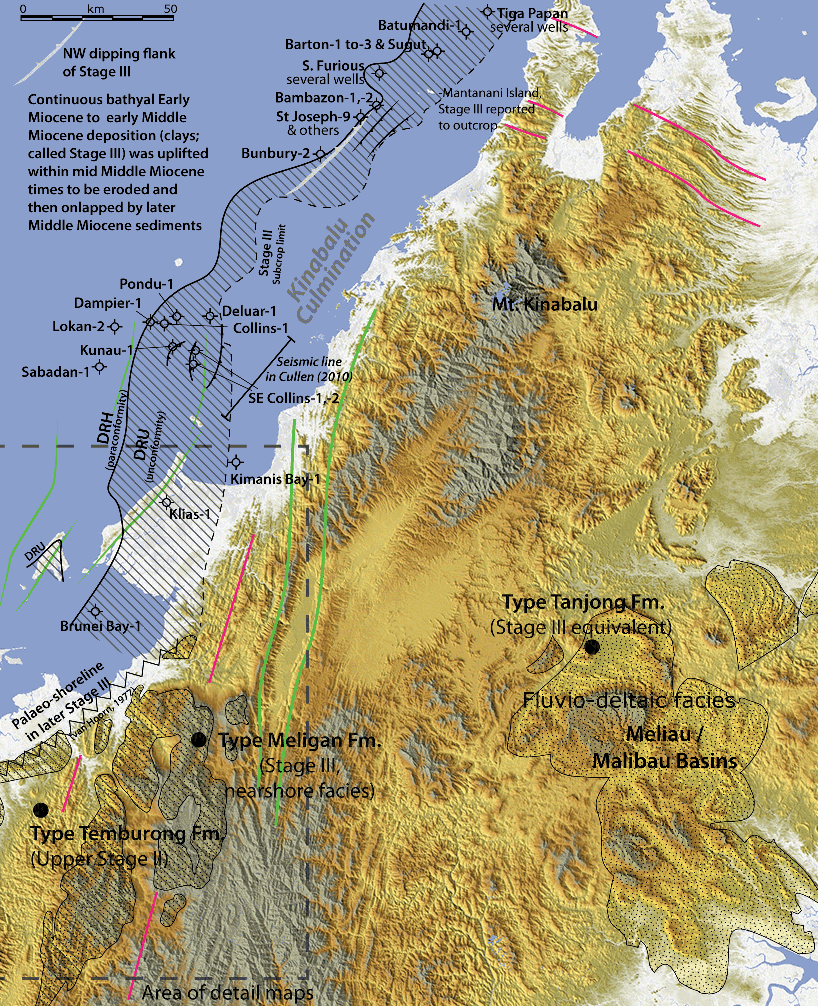Lunt, P., 2021. Re-examination of the Base Miocene Unconformity in West Sabah and its part in the tectono-stratigraphic development of the region. Journal of Asian Earth Sciences
This paper followed on from a review of the Kudat area to the north. In an ideal world it would have been good to combine them into a single paper, but the amount of clarification and validation of basic stratigraphic information would make such a paper too long. This is a symptom of neglect in a basic science.
This West Sabah paper did have one new theme, and that was a question raised by Chris Morley about the Base Miocene Unconformity (BMU). Could it be a structural dislocation surface (which would cut across formations) rather than a stratigraphic event? This was a point also raised by Robert Tate in 1994 in a review of the Sungai Temburong type section of the Temburong Formation. The answer is No, for reasons explained in the paper.
Having re-examined data over a wide area, following workers over some 70 years, a single outstanding unconformity was noted between beds with Letter Stages Te4 (or slightly wider Te2-4 age in some places) and Te5 age sediments. Much of the paper deals with old observations, relocated on modern topography images, and microfossil data updated to modern (and well-tested) taxonomic concepts.
Other stratigraphic concepts updated include notes on the hypothesis of the Top Crocker Unconformity (TCU) that was a term proposed for a theoretical surface at the end of subduction-deformed Crocker Formation, before onset of docking or collision deformation of later sediments. Both this term and the alternative Base Miocene Unconformity (BMU) have poor histories in the publication record, so neither can claim to be strictly “senior”, but at least the BMU is based on simple observation of Late Oligocene Te4 being much more deformed than overlying Te5 beds. The definition of the TCU (Hall et al., 2008) was a hypothesis, and one that does not seem to be valid; that is – the end of plate docking (collision) after subduction of the Proto-South China Sea plate.
It can be observed that the deformation leading up to the BMU in West Sabah occurred in the same narrow age range as the deformation of the Kudat Fm. in NW Sabah, yet they have perpendicular strike of lineament, which is significant. The Wariu Formation sheared mélange, also of Late Oligocene age, is noted to occur only in the region where these perpendicular deformation structures converge.

This paper then reviews the latest Oligocene through Early Miocene history of a wider area around northern Borneo and its incompatibility with any subduction of a Proto-South China Sea plate, and collision/docking of a plate of Dangerous Grounds. In particular the Oligocene deformation was restricted to the southern part of the required collision zone, with an incompatible direction of stress, and the converging L shape deformation indicative of limited lateral strain. Then at ridge-jump, and expansion of plate drift into the central South China Sea, the north Borneo deformation ended and the region subsided – at a time when PSCS models suggests deformation should have accelerated.
The paper also describes the lack of evidence for any plate convergence around the northern part of the Palawan continental terrane, and a complete absence of any indication of docking collision. The margin of any migrating plate must have had a stratigraphic signature, either extension, compression or transform wrenching, but north Palawan has none until a Late Miocene compression of the adjacent Panay Island. The Ulugan Bay transform fault postulated across central Palawan is only a hypothesis and lacks any seismic or outcrop evidence.
References
Hall, R., van Hattum, M.W.A., Spakman, W., 2008. Impact of India–Asia collision on SE Asia: The record in Borneo. Tectonophysics 451, 366-389
Tate, R.B., 1994. The sedimentology and tectonics of the Temburong Formation – deformation of early Cenozoic deltaic sequences in NW Borneo. Geological Society Malaysia Bulletin 35, 97-112
Be First to Comment